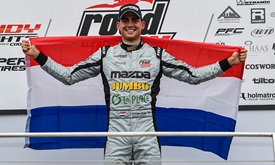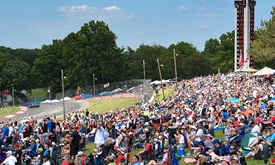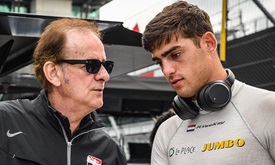It's somewhat mysterious, but 3D printing helping INDYCAR teams
DEC 06, 2019
The concept of 3D printing isn’t anything new in motorsports. In fact, variations of the technology have been around the sport for two decades. The difference between then and now is the scope of what it can accomplish, how it’s being used and how it allows teams to save time for other, more pressing issues in building and engineering race cars.
“Twenty years ago, 3D printing it was our version of Etch A Sketch,” said Mike Hull, managing director of Chip Ganassi Racing. “It’s totally changed. What happens is that things like this exist before we find out about them. Maybe it’s the NSA or the government or somebody else, but finally it becomes available to the public, and away we go. Once we were on to it, we were on to it.”
It is somewhat mysterious, but 3D printing has a variety of practical uses in everyday life that most people don’t realize. It’s used extensively in medical fields. Dental work, prosthetics and eyewear are some of the most common applications. It’s used extensively in the automotive and aviation industries, in architecture, and in the design of common household appliances and furniture.
By definition, 3D printing is the process of making three-dimensional objects from a digital file that’s achieved via additive processes, which use successive layers to help design and build the object. That’s different from traditional subtractive manufacturing, which cuts or hollows out a piece of metal or plastic, thus allowing 3D printing to use less material than traditional manufacturing methods. Sounds complicated, but it’s actually quite simple. And it’s become an important step in designing, building and engineering race cars.
All INDYCAR teams have some variation of 3D printing capabilities, but -- as with all forms of technology -- the well-funded teams have the latest equipment and most extensive capabilities. Several have portable 3D printing equipment, allowing them to use computer-aided design (CAD) to print and test components at the racetrack.
“The key thing for us is the amount of time it saves us,” said Tom German, technical director at Rahal Letterman Lanigan Racing. “When you draw something in a CAD system and want to have it made by a machine or fabricated the conventional way, you go through a process of modeling it in CAD, which is a 3D process, and then you process a series of 2D drawings that are instructions for the machinist or fabricator to make the part. In the 3D printing world, we create that 3D model in CAD, save it, load it into the printer and make the part. It doesn’t sound like a lot, but it saves an incredible amount of time.”
And that’s the point. In the fast-paced, ever-changing world of motorsports, 3D printing allows teams to accomplish basic production tasks in far less time and with far less material than was needed previously. Not only does it save time, it also saves money and allows engineers to focus on broader issues.
“What we learned to do as we’ve gone along with 3D technology is to take something that originally was very difficult to accomplish and make it very easy,” Hull explained. “That gives you the opportunity to work on other, harder projects. What things like 3D printing do for any technologically driven industry is give you the time during the day to solve complicated problems. This used to be a complicated issue, but now it’s very easy. It’s gives us the ability to manage time better based on priority. That’s really what it is and what is has become. You define your priorities, and -- boom -- it takes care of it for you. So now we’re working on things that five years from now people will be asking, ‘Wow, how does that work?’ We’re working on those things now.”
Last year, Rahal Letterman Lanigan Racing formed a technical partnership with XYZ Printing, a 3D printing firm that assists with the team’s in-house and on-track 3D printing production.
“We’re able to do it right in the shop or on the truck at the racetrack,” German said. “In a matter of hours, you can have a part for a car and make sure that it fits properly. That’s one area that everybody uses 3D printing for -- anybody in any kind of engineering or design-type world -- is building test-fit parts. It helps you understand the operation of a part. If you have a complex part and you’re trying to visualize how it all fits together, having the parts in your hand and being able to put them together is a huge advantage.”
The technology also eases the expense and time of full-scale wind-tunnel testing. Parts can be produced at smaller scale and tested, instead of taking the full-sace part -- or entire car -- to a wind tunnel, which allows teams to experiment with various parts in a way that’s far more complex and productive than the cumbersome way teams experimented before 3D printing technology.
Looking for an example? Front wings. Pre-3D, designing, building and testing wings was a laborious exercise. Now, the process is -- pardon the pun -- streamlined.
“Before 3D printing, we would have had to draw each design, create molds for each design, have those molds produced and have those parts made up, and then test all of those parts,” German said. “There’s quite a long supply chain of getting all of those parts to the test facility and evaluating them. But with 3D printing, we can create a CAD model and change certain aspects of it before it’s printed. We then save each of those files and put them into a 3D machine and have all those parts made. We’ve completely skipped the making of molds for the carbon fiber parts, curing them, trimming them and putting them on the car. We’ve skipped all of that and gone straight from CAD to 10 different options to take to the wind tunnel test.”
When he thinks about the rapidity of change in technology and the acceptance of it, Hull is reminded of the late Mo Nunn, the Formula One and INDYCAR team owner who worked with Ganassi’s team before starting Mo Nunn Racing in 2000.
“Morris Nunn was so good at what he did. Most of our guys viewed him as an old-school engineer who still used pen and paper, but what was so terrific about him was that he accepted the fact that young, aggressive engineers were going to become the future of motor racing. He relied totally on what they said. He would ask them to solve a problem for them that he wasn’t able to solve himself, but he understood the answer. He got the answers quicker. That’s in the direction of what we’re speaking about with 3D printing. No matter where you are generationally, you have to accept what modern technology can do for you. You have to rely on the people and technology that can give you the answers quickest. That’s what this does.”



















